 |
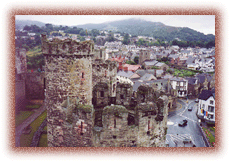 CONWY This castle is in North Wales in a town called Conwy. It was built by Edward I of England, shortly after he conquered Wales and kicked the Welsh princes out of their own country. Or, more accurately, his soldiers killed the last Llywelyn, chopped off his head, and then executed his brother Dafydd in the first recorded example of "drawing and quartering," which I understand is not a very nice way to die. At any rate, Edward came to the Northern tip of Wales and had this castle built. It is absolutely massive. The castle itself has several huge towers and there are crumbling walls that date from the same time period surrounding the town. In some parts of the town you actually have to drive through the castle wall "keyholes" in order to get around. The keyholes are almost exactly as wide as a Fiat Punto, which believe me is not very wide. If two cars are trying to go through in opposite directions one will have to back up and wait. (By the way, these images are all clickable) CONWY This castle is in North Wales in a town called Conwy. It was built by Edward I of England, shortly after he conquered Wales and kicked the Welsh princes out of their own country. Or, more accurately, his soldiers killed the last Llywelyn, chopped off his head, and then executed his brother Dafydd in the first recorded example of "drawing and quartering," which I understand is not a very nice way to die. At any rate, Edward came to the Northern tip of Wales and had this castle built. It is absolutely massive. The castle itself has several huge towers and there are crumbling walls that date from the same time period surrounding the town. In some parts of the town you actually have to drive through the castle wall "keyholes" in order to get around. The keyholes are almost exactly as wide as a Fiat Punto, which believe me is not very wide. If two cars are trying to go through in opposite directions one will have to back up and wait. (By the way, these images are all clickable) |
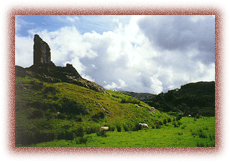 DOLWYDDELAN This castle is called Dolwyddelan (pronounced "Dol-wuh-the-lan," at least I think that's how it's pronounced). It was used primarily by Llywelyn Fawr (Llywelyn the Great, not to be confused with Llywelyn the Last, whose unfortunate fate is outlined above). Llywelyn Fawr was one of the last Welsh-born princes of Wales. He lived in the early 13th century. Llywelyn was best known for actually managing to keep the English out of Wales. He achieved this in part by marrying the English king's illegetimate daughter Joan, but also because, unlike his descendents, he knew when to back off and let the English king have his way. This castle was one of Llywelyn's favorite residences and although popular myth makes this his birthplace, it is more likely that he commissioned it within his lifetime and was actually born at a location nearby. This photo is of the remains of the West Tower. DOLWYDDELAN This castle is called Dolwyddelan (pronounced "Dol-wuh-the-lan," at least I think that's how it's pronounced). It was used primarily by Llywelyn Fawr (Llywelyn the Great, not to be confused with Llywelyn the Last, whose unfortunate fate is outlined above). Llywelyn Fawr was one of the last Welsh-born princes of Wales. He lived in the early 13th century. Llywelyn was best known for actually managing to keep the English out of Wales. He achieved this in part by marrying the English king's illegetimate daughter Joan, but also because, unlike his descendents, he knew when to back off and let the English king have his way. This castle was one of Llywelyn's favorite residences and although popular myth makes this his birthplace, it is more likely that he commissioned it within his lifetime and was actually born at a location nearby. This photo is of the remains of the West Tower. |
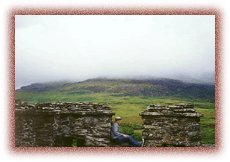 Dolwyddelan again; I am sitting on top of the Great Keep, which has been restored within the last 150 years or so. Behind me are the Snowdonia mountains, which were hidden by clouds at the time this photo was taken. From where I'm sitting, you can look down on the remains of the West Tower. Bear in mind that all of these photos were taken in early August. Wales is no California. It rains constantly there, which can be quite annoying when you are in a rental car sitting on the wrong side of the car with the gearshift in the wrong hand driving down the wrong side of the road with absolutely no idea where you are going. But, the rain really keeps the country beautiful and green. Dolwyddelan again; I am sitting on top of the Great Keep, which has been restored within the last 150 years or so. Behind me are the Snowdonia mountains, which were hidden by clouds at the time this photo was taken. From where I'm sitting, you can look down on the remains of the West Tower. Bear in mind that all of these photos were taken in early August. Wales is no California. It rains constantly there, which can be quite annoying when you are in a rental car sitting on the wrong side of the car with the gearshift in the wrong hand driving down the wrong side of the road with absolutely no idea where you are going. But, the rain really keeps the country beautiful and green. |
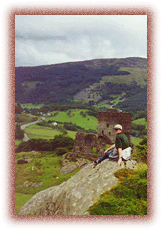 Here is Dolwyddelan as seen from a distance. In front you can see the ruined West Tower and behind it is the restored Great Keep. You can go inside the Great Keep, where there is a fireplace and several rooms at different levels. You're not allowed to go down to some of the rooms, but you can climb up onto the top and walk on the battlements, where the view is really breathtaking. Dolwyddelan is quite small compared to Conwy and some of the other castles we visited on our trip, but it is one of only a few examples of restored or intact castles that were actually built and occupied by the Welsh princes. There are an awful lot of English castles in Wales. The squarish style that you see in the Dolwyddelan ruins is typical of the Welsh; the English preferred round towers and considered castles like this one to be unfashionable. The English royalty was also famous for excess; hence the big, impressive looking castles vs. the humble Welsh castles like this one. Here is Dolwyddelan as seen from a distance. In front you can see the ruined West Tower and behind it is the restored Great Keep. You can go inside the Great Keep, where there is a fireplace and several rooms at different levels. You're not allowed to go down to some of the rooms, but you can climb up onto the top and walk on the battlements, where the view is really breathtaking. Dolwyddelan is quite small compared to Conwy and some of the other castles we visited on our trip, but it is one of only a few examples of restored or intact castles that were actually built and occupied by the Welsh princes. There are an awful lot of English castles in Wales. The squarish style that you see in the Dolwyddelan ruins is typical of the Welsh; the English preferred round towers and considered castles like this one to be unfashionable. The English royalty was also famous for excess; hence the big, impressive looking castles vs. the humble Welsh castles like this one. |
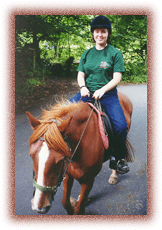 HORSEBACK RIDING Anyone who knows me knows I can't go anywhere without doing some horseback riding. In Wales this is called "Pony Trekking." We went on our ride with the Llangenny Riding Centre in Brecon Beacons National Park, which is on the eastern border of Wales in the Black Mountains. The really lovely thing about riding in the UK is the complete lack of liability laws, which means that instead of being limited to riding a nice, safe, lame, boring old nag you actually get to ride something interesting. This is Nora and her horse, a smallish chestnut mare whose name I can't remember. I rode a pinto Irish Cob called "Patch." Galloping, which in a million years you would never be allowed to do on a rental string in California, was actually encouraged by our guides. I can honestly say that it was the fastest I have ever gone on a horse. I would never dare go that fast on my own horse (she would never stop), and the opportunities for such things are rare around here anyway (can you imagine what the hikers at Calero would do if you came busting down the hill at break-neck speed). But when you have nothing but a vast expanse of open country in front of you, and no one who cares, you could go like that for a long time, and as fast as you like. HORSEBACK RIDING Anyone who knows me knows I can't go anywhere without doing some horseback riding. In Wales this is called "Pony Trekking." We went on our ride with the Llangenny Riding Centre in Brecon Beacons National Park, which is on the eastern border of Wales in the Black Mountains. The really lovely thing about riding in the UK is the complete lack of liability laws, which means that instead of being limited to riding a nice, safe, lame, boring old nag you actually get to ride something interesting. This is Nora and her horse, a smallish chestnut mare whose name I can't remember. I rode a pinto Irish Cob called "Patch." Galloping, which in a million years you would never be allowed to do on a rental string in California, was actually encouraged by our guides. I can honestly say that it was the fastest I have ever gone on a horse. I would never dare go that fast on my own horse (she would never stop), and the opportunities for such things are rare around here anyway (can you imagine what the hikers at Calero would do if you came busting down the hill at break-neck speed). But when you have nothing but a vast expanse of open country in front of you, and no one who cares, you could go like that for a long time, and as fast as you like. |
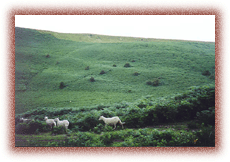 Here is some of the terrain in the place where we rode. The entire hillside is covered with a knee high blanket of ferns, which is something I have never seen anywhere in the US. The trail took us past old stone farmhouses and places that have not changed in centuries. And of course there are sheep everywhere. When they say that Wales is full of sheep, you can't really understand the extent to which they mean "Wales is full of sheep." They literally are everywhere. I think there are more of them than people. They live in pastures, but also in castle ruins and in the middle of towns, and all over the Black Mountains. We scattered them every time we went down a new trail. Here is some of the terrain in the place where we rode. The entire hillside is covered with a knee high blanket of ferns, which is something I have never seen anywhere in the US. The trail took us past old stone farmhouses and places that have not changed in centuries. And of course there are sheep everywhere. When they say that Wales is full of sheep, you can't really understand the extent to which they mean "Wales is full of sheep." They literally are everywhere. I think there are more of them than people. They live in pastures, but also in castle ruins and in the middle of towns, and all over the Black Mountains. We scattered them every time we went down a new trail. |
|
 |
 |
|
